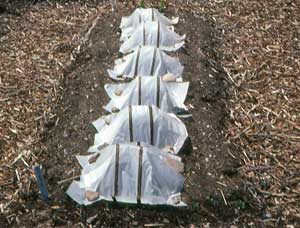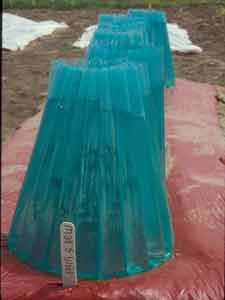Bulletin #2752, Extending the Gardening Season
Developed by Marjorie Peronto, Associate Extension Professor; and Theresa Guethler, Extension Master Gardener.
For information about UMaine Extension programs and resources, visit extension.umaine.edu.
Find more of our publications and books at extension.umaine.edu/publications/.
Many vegetable crops are very sensitive to cold weather, and the majority of them grow only during the frost-free months of the year. This greatly limits the length of the growing season in Maine. There are several methods that you can use to help protect your plants from the cold and extend our short growing season.
Materials such as plastic mulches and row covers can speed up crop development and allow you to harvest earlier by raising soil temperatures and/or daytime air temperatures around the plant. Structures such as cold frames and hoop houses can extend the growing season at its beginning and end. Surrounding individual plants in the garden with hot caps, such as insulating plastic water tubes or wax paper caps, can keep your plants a few degrees warmer during cold nights and speed up growth.
Plastic Mulches
Plastic mulches help conserve soil moisture, reduce soil erosion, and inhibit weed growth. When stretched tightly over the garden soil surface, they warm the soil, leading to earlier harvest and increased yields, which is most helpful with heat-loving crops like melons, peppers, and tomatoes. They also improve the quality of your harvest by keeping the edible portions of the plants off the ground. Disadvantages of plastic mulches include the cost and potential disposal problems.
When applying a plastic mulch, follow these steps:
- Smooth the soil evenly. Make sure the soil is moist.
- Stretch the plastic tightly over the soil, and bury all edges.
- Cut or burn planting holes in the plastic.
- Plant seedlings or seeds through the holes.
- Since colored plastic mulches are left on the soil for the whole gardening season, check soil moisture regularly, and water as needed through the planting holes. Better yet, before laying down the plastic mulch, install a simple drip irrigation system to keep the soil evenly moist.
Clear Plastic Mulch

Clear plastic mulch warms the soil more than any other type of plastic mulch since it allows the sun’s rays to penetrate. It is typically used to solarize a garden plot, and removed before planting: solarizing kills weeds and disease organisms in the top 6 inches of soil. Cover moist garden soil tightly with clear plastic for the six hottest weeks of the summer. The soil will heat up to as high as 125°F. Weeds will initially grow, but will eventually die from the extreme heat and lack of air exchange. When you remove the plastic, the garden is weed free and ready for planting. Using clear plastic on the ground around crop plants (such as you might do with black plastic) could create excessive heat and injure the crop.
Black Plastic Mulch
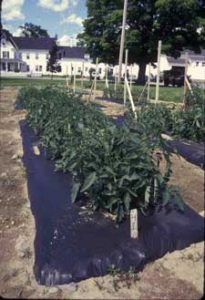
Black plastic warms the soil less than clear plastic, but because it blocks the sun’s rays, it suppresses weed growth. In order to get good soil warming with black plastic, make sure it is pressed flat for good contact with the soil surface. Black plastic also helps retain soil moisture by reducing evaporation, so plants may need to be watered less.
Infrared-Transmitting (IRT) Mulch
This mulch has a dark greenish or brown color. It is a “hybrid” of clear and black plastic, with intermediate soil-warming and weed-suppression abilities. This mulch combines the positive qualities of clear and black plastic mulches: it allows infrared light rays through, which warm the soil, but blocks most other light rays, which keeps weed growth beneath it to a minimum. It tends to be significantly more expensive than black plastic.
Other Colored Mulches
Red, dark blue, silver, yellow, orange, and white plastic mulches have been developed in an effort to improve plant growth and yield. White and silver mulches have been found to slightly reduce soil temperature, making them most useful in southern climates. Mulches of other colors reflect different light rays into the plant canopy, sometimes improving plant growth or increasing insect activity. Unlike black plastic, colored plastics often allow weed growth beneath them. Results of research with colored mulches have been somewhat contradictory.
Row Covers
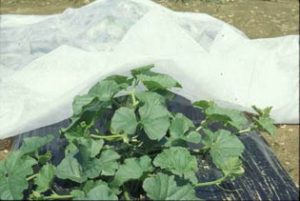
Rather than being placed on the soil around the bases of the plants, a row cover is put over the growing plants to create a greenhouse effect. Row covers are made either of perforated plastic or of spunbonded or woven synthetic materials. They enhance growth by raising daytime air temperature around plants by up to 10°F, and insulate the plants with residual heat at night. They offer some wind and frost protection and provide a barrier to pests. It is important to secure all edges when installing them so that they don’t blow around. However, you will need to remove the row covers for pollination. Like plastic mulches, these materials can be costly and labor-intensive and can be a disposal problem. However, if handled and stored properly, they may be used for several seasons.
Spunbonded/Woven Fabric
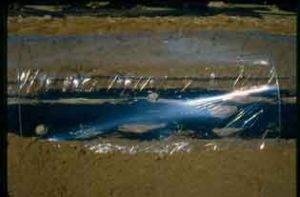
Spunbonded or woven row covers are lightweight, white fabrics that allow air, water, and sunlight to pass through, but trap heat inside and serve as a barrier to wind and insect pests. This type of row cover can be supported with hoops, or laid loosely over plants and allowed to “float.” Either way, it is important to secure down all edges to keep the covers from blowing away. If stored properly, they may last two to three years.
Slitted or Perforated Clear Plastic
This type of row cover is too heavy to be laid directly on plants and must be supported by wire hoops. It has pre-cut slits or holes so that excess hot air can escape. It is commonly used in combination with black plastic mulch for weed control. Although plant growth is certainly enhanced under this type of row cover, you will need to monitor temperature carefully to avoid overheating on sunny days.
Cold Frames
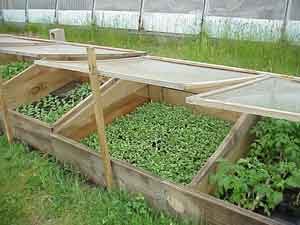
A cold frame is simply a bottomless box placed over the plants, with a glass or clear plastic top that lets in the sunlight and opens to allow ventilation. It can be built from a variety of materials. It is generally used to harden seedlings off and protect direct-seeded crops from cold temperatures. Cold frames offer a greater degree of frost protection than floating row covers, but if not monitored carefully, they can overheat. Disadvantages include bulkiness and high cost (if purchased ready-made).
When using a cold frame, be mindful of the following:
- Select a site with well-drained soil.
- Orient the glass face toward the south to southeast.
- Monitor the temperature inside the frame and adjust the opening to ventilate and prevent overheating.
Hoop Houses
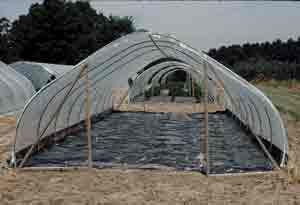
A hoop house, or high tunnel, is a temporary, no-frills greenhouse structure that can produce earlier crop yields. The frame, which is covered with a single layer of greenhouse plastic, is made from metal bows that are secured to in-ground metal posts. The sides are fastened to a movable bar that can be manually rolled up in the morning and down in the evening for temperature control. Keep in mind that hoop houses are costly and labor-intensive, and when you use them, monitoring and managing air temperature and pests is critical.
Hot Caps
A hot cap is a cone-, bell-, or tent-shaped individual plant cover that acts as a miniature greenhouse, trapping heat from the sun. These types of covers raise soil and daytime air temperatures, accelerating germination and plant growth while providing some frost and wind protection.
Wax Paper Cap
While this cover shelters plants from wind and discourages insect pests, it also greatly reduces light transmission to plants.
Insulating Plastic Water Tubes
This is a flexible ring of connected plastic tubes which, when filled with water and placed around a young plant, gives frost protection by keeping the air around the plant several degrees warmer. However, these covers are costly and labor-intensive, so they are practical only for small plantings of high-value crops. These are often sold under the trade names Wall O’ Water and Kozy Coat.
- Wax paper hot caps covering plants and being held down with rocks. Photo by Marjorie Peronto.
- Rings of plastic water tubes wrapped around and insulating plants. Photo by David Handley.
Further Resources
Bachman, Janet. “Plasticulture for Season Extension.” Season Extension Techniques for Market Gardeners. ATTRA Publication #IP035. Fayetteville, AR: National Sustainable Agriculture Information Service, 2005.
Center for Plasticulture at Penn State. “Center for Plasticulture.” Department of Horticulture, College of Agricultural Sciences, The Pennsylvania State University, 2003.
Coleman, Eliot and Barbara Damrosch. Four-Season Harvest: Organic Vegetables From Your Home Garden All Year Long. 2nd ed. White River Jct., VT: Chelsea Green, 1999.
Reviewed by David Handley, Extension Professor and Cooperating Professor of Horticulture; and Barbara Murphy, Associate Extension Professor.
Additional assistance and reviews by Barbara Grunden and Sarah Tyson, Extension Master Gardeners.
Brand names and trade names are included for educational purposes. No endorsement is implied nor is discrimination intended against similar products or services.
Information in this publication is provided purely for educational purposes. No responsibility is assumed for any problems associated with the use of products or services mentioned. No endorsement of products or companies is intended, nor is criticism of unnamed products or companies implied.
© 2008
Call 800.287.0274 (in Maine), or 207.581.3188, for information on publications and program offerings from University of Maine Cooperative Extension, or visit extension.umaine.edu.
The University of Maine is an EEO/AA employer, and does not discriminate on the grounds of race, color, religion, sex, sexual orientation, transgender status, gender expression, national origin, citizenship status, age, disability, genetic information or veteran’s status in employment, education, and all other programs and activities. The following person has been designated to handle inquiries regarding non-discrimination policies: Sarah E. Harebo, Director of Equal Opportunity, 101 North Stevens Hall, University of Maine, Orono, ME 04469-5754, 207.581.1226, TTY 711 (Maine Relay System).


